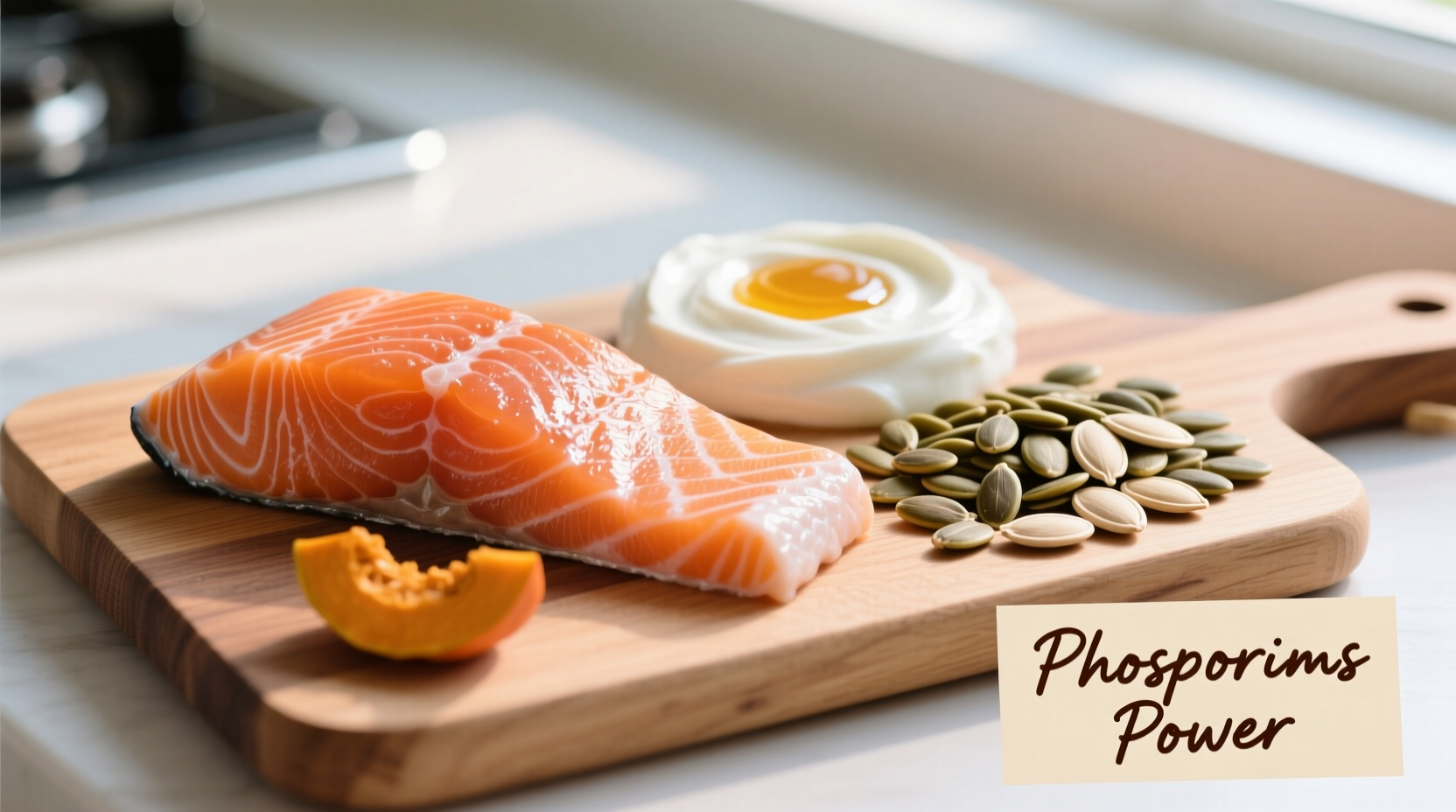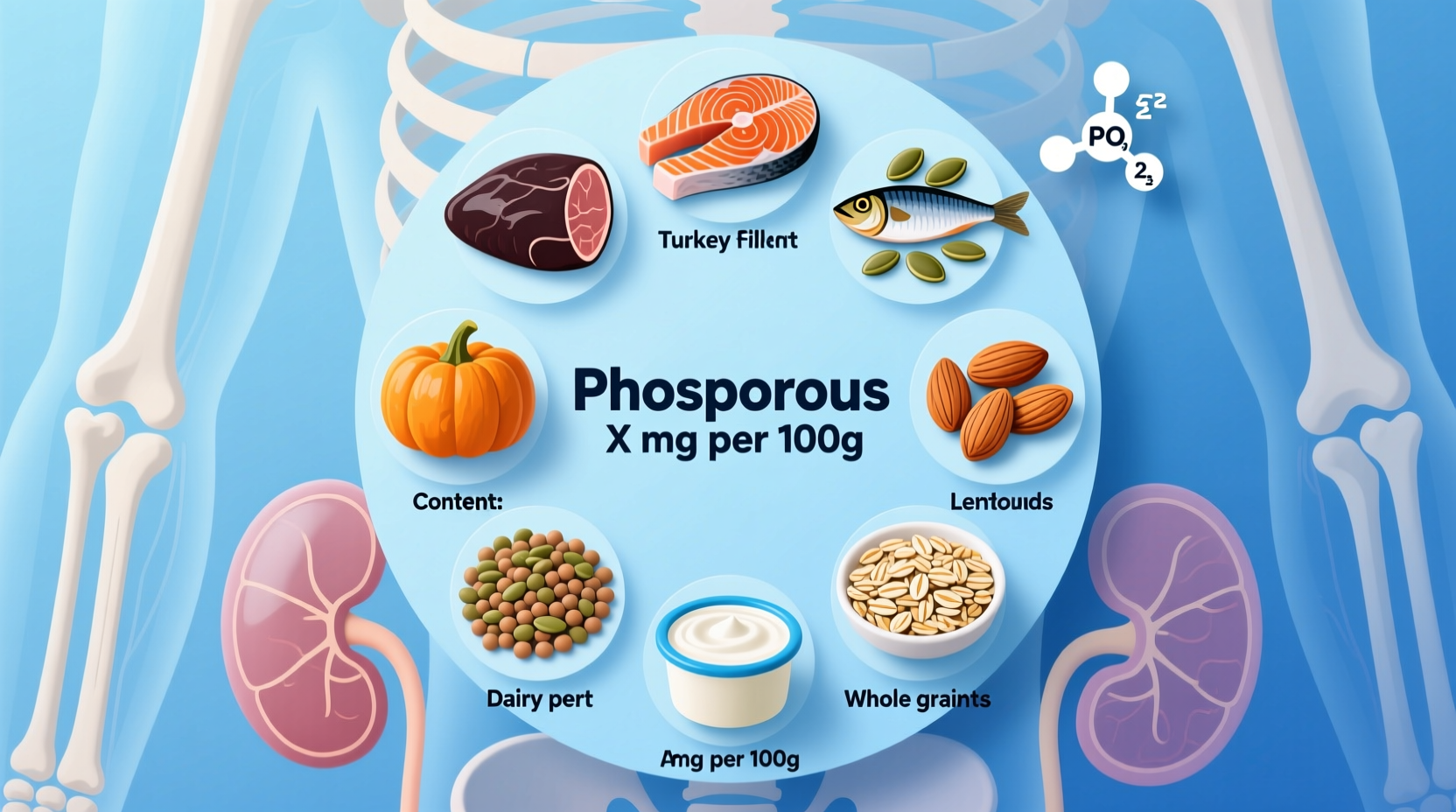Top phosphorus-rich foods include dairy products (milk, yogurt, cheese), fish (salmon, tuna), poultry (chicken, turkey), red meat, nuts and seeds (pumpkin seeds, sunflower seeds), legumes (lentils, beans), and whole grains. A single serving of many these foods provides 20-40% of the daily recommended intake of 700 mg for adults.
Discover exactly which foods deliver the most phosphorus per serving and how to incorporate them into your diet based on your specific health needs. This comprehensive guide provides science-backed information on phosphorus-rich foods with practical meal planning tips, clear nutritional comparisons, and important considerations for those with kidney conditions or other health concerns.
Why Phosphorus Matters for Your Health
Phosphorus works alongside calcium to build strong bones and teeth, making up about 1% of your total body weight. This essential mineral also plays critical roles in:
- Energy production at the cellular level
- DNA and RNA formation
- Proper kidney function and waste filtration
- Nerve conduction and muscle contraction
- Maintaining healthy blood pH levels
The National Institutes of Health recommends a daily intake of 700 mg for adults, though requirements vary by age and health status. Children aged 9-18 need 1,250 mg daily for proper bone development, while adults over 70 should maintain the standard 700 mg intake.

Top Animal-Based Phosphorus Sources
Animal proteins typically provide highly bioavailable phosphorus that your body can easily absorb. Here's what to include in your regular rotation:
| Food | Serving Size | Phosphorus (mg) | % Daily Value |
|---|---|---|---|
| Salmon (cooked) | 3 oz | 252 | 36% |
| Chicken breast | 3 oz | 226 | 32% |
| Lean beef | 3 oz | 211 | 30% |
| Low-fat milk | 1 cup | 205 | 29% |
| Plain yogurt | 1 cup | 306 | 44% |
Plant-Based Phosphorus Powerhouses
For vegetarians, vegans, or those looking to diversify protein sources, these plant foods deliver substantial phosphorus. Note that plant-based phosphorus has lower bioavailability due to phytic acid content, though soaking, sprouting, or fermenting can improve absorption.
| Food | Serving Size | Phosphorus (mg) | % Daily Value |
|---|---|---|---|
| Pumpkin seeds | 1 oz | 357 | 51% |
| Lentils (cooked) | 1 cup | 356 | 51% |
| Chickpeas | 1 cup | 276 | 39% |
| Quinoa (cooked) | 1 cup | 281 | 40% |
| Almonds | 1 oz | 134 | 19% |
Understanding Phosphorus Bioavailability
Not all phosphorus sources are equally accessible to your body. Animal proteins provide 40-70% bioavailable phosphorus, while plant sources typically offer 20-50% due to phytic acid binding. Processed foods often contain phosphate additives with nearly 100% absorption rate, which can be problematic for certain populations.
According to research from the NIH Office of Dietary Supplements, the average American consumes 1,000-1,500 mg of phosphorus daily, primarily from both natural food sources and additives. The concern isn't usually deficiency but rather excess intake, particularly from processed foods containing phosphate additives.
Special Considerations for Kidney Health
For the approximately 37 million Americans with chronic kidney disease, phosphorus management becomes critical. Healthy kidneys remove excess phosphorus, but compromised kidneys cannot, leading to dangerous buildup. The National Kidney Foundation recommends limiting phosphorus to 800-1,000 mg daily for those with moderate to severe kidney disease.
Key strategies for kidney patients include:
- Limiting processed foods with phosphate additives (check ingredient lists for words containing "phos")
- Choosing fresh over packaged foods whenever possible
- Working with a renal dietitian to balance nutrient needs
- Understanding that dairy alternatives like almond milk typically contain less phosphorus than cow's milk
Practical Meal Planning with Phosphorus-Rich Foods
Here's how to incorporate these nutrient-dense foods into your daily routine based on your specific needs:
For Active Individuals and Athletes
Pair phosphorus-rich salmon with quinoa and roasted vegetables for a complete post-workout meal that supports muscle recovery and energy production. The combination of high-quality protein and complex carbohydrates with phosphorus creates an ideal recovery profile.
For Bone Health Support
Create a calcium-phosphorus synergy by combining Greek yogurt with pumpkin seeds and berries. This snack delivers both minerals in the proper ratio for optimal bone formation. The vitamin C from berries further enhances mineral absorption.
For Kidney-Conscious Eating
Focus on moderate portions of lower-phosphorus protein sources like egg whites while avoiding high-phosphorus processed foods. A renal-friendly meal might include grilled chicken breast (small portion), green beans, and rice instead of higher-phosphorus alternatives.
Avoiding Common Phosphorus Pitfalls
Many people unknowingly consume excessive phosphorus through processed foods. The USDA's Economic Research Service reports that phosphate additives appear in approximately 50% of packaged foods, contributing significantly to daily intake without consumers realizing it.
Be particularly cautious with:
- Colas and other dark sodas (contain phosphoric acid)
- Processed cheeses and cheese spreads
- Delicious meats and packaged seafood
- Instant pudding and other convenience desserts
- Commercial baked goods with leavening agents
Reading ingredient labels for terms like "phosphate," "polyphosphate," or any word containing "phos" can help you identify hidden sources of phosphorus additives.
When Supplementation Might Be Necessary
While most people get sufficient phosphorus from food, certain conditions may require supplementation under medical supervision:
- Severe malnutrition or eating disorders
- Certain genetic disorders affecting phosphate metabolism
- Prolonged use of medications that interfere with phosphorus absorption
- Recovery from severe burns or trauma
Never supplement phosphorus without consulting a healthcare provider, as excess intake can lead to calcium depletion and vascular calcification. The FDA notes that phosphorus toxicity typically occurs only with excessive supplementation, not from food sources alone.
Creating Balanced Phosphorus Intake
The key to healthy phosphorus consumption isn't simply maximizing intake but achieving proper balance with other nutrients, particularly calcium. The ideal calcium-to-phosphorus ratio for bone health ranges between 1:1 and 2:1.
Monitor your overall dietary pattern rather than focusing on single nutrients. A Mediterranean-style diet rich in whole foods naturally provides appropriate phosphorus levels without excess. For most healthy adults, simply incorporating a variety of the phosphorus-rich foods listed above within a balanced diet will meet your nutritional needs without requiring special attention to this mineral.











 浙公网安备
33010002000092号
浙公网安备
33010002000092号 浙B2-20120091-4
浙B2-20120091-4